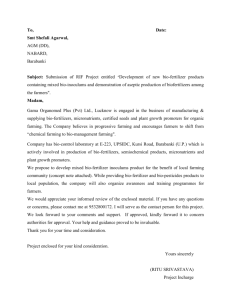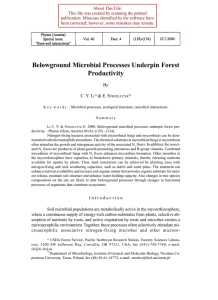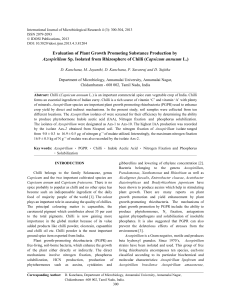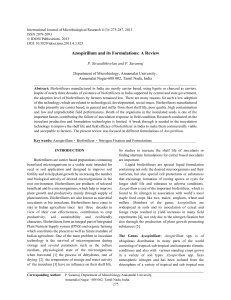1 Dobbelaere, S., Croonenborghs, A., Thys, A., Ptacek, D
advertisement
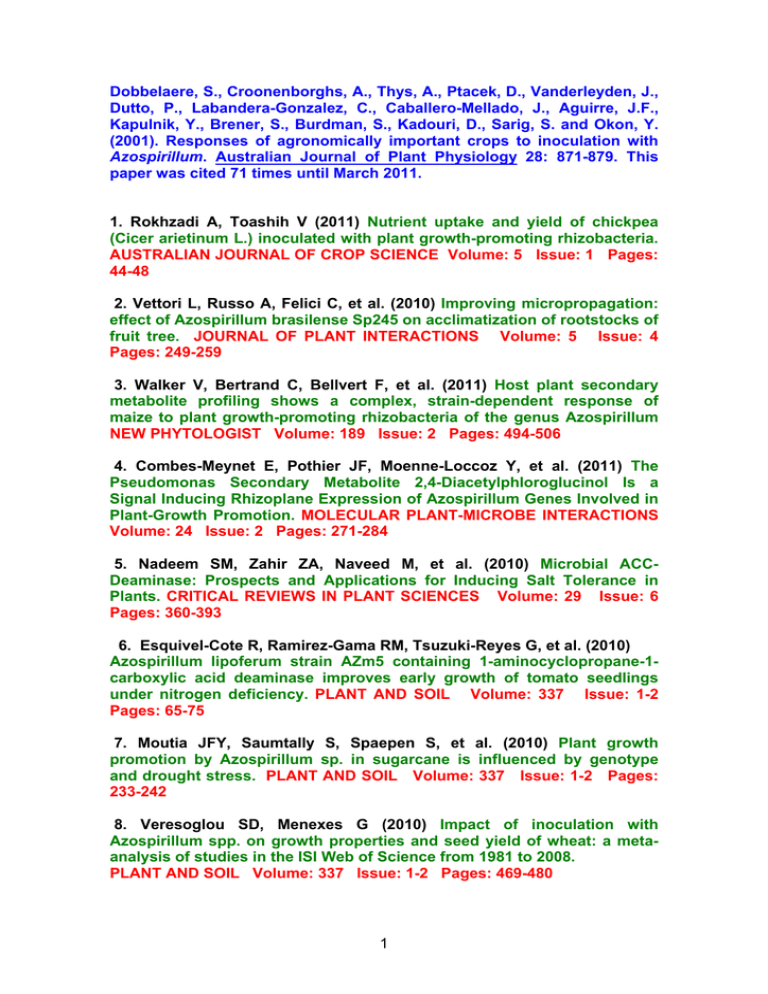
Dobbelaere, S., Croonenborghs, A., Thys, A., Ptacek, D., Vanderleyden, J., Dutto, P., Labandera-Gonzalez, C., Caballero-Mellado, J., Aguirre, J.F., Kapulnik, Y., Brener, S., Burdman, S., Kadouri, D., Sarig, S. and Okon, Y. (2001). Responses of agronomically important crops to inoculation with Azospirillum. Australian Journal of Plant Physiology 28: 871-879. This paper was cited 71 times until March 2011. 1. Rokhzadi A, Toashih V (2011) Nutrient uptake and yield of chickpea (Cicer arietinum L.) inoculated with plant growth-promoting rhizobacteria. AUSTRALIAN JOURNAL OF CROP SCIENCE Volume: 5 Issue: 1 Pages: 44-48 2. Vettori L, Russo A, Felici C, et al. (2010) Improving micropropagation: effect of Azospirillum brasilense Sp245 on acclimatization of rootstocks of fruit tree. JOURNAL OF PLANT INTERACTIONS Volume: 5 Issue: 4 Pages: 249-259 3. Walker V, Bertrand C, Bellvert F, et al. (2011) Host plant secondary metabolite profiling shows a complex, strain-dependent response of maize to plant growth-promoting rhizobacteria of the genus Azospirillum NEW PHYTOLOGIST Volume: 189 Issue: 2 Pages: 494-506 4. Combes-Meynet E, Pothier JF, Moenne-Loccoz Y, et al. (2011) The Pseudomonas Secondary Metabolite 2,4-Diacetylphloroglucinol Is a Signal Inducing Rhizoplane Expression of Azospirillum Genes Involved in Plant-Growth Promotion. MOLECULAR PLANT-MICROBE INTERACTIONS Volume: 24 Issue: 2 Pages: 271-284 5. Nadeem SM, Zahir ZA, Naveed M, et al. (2010) Microbial ACCDeaminase: Prospects and Applications for Inducing Salt Tolerance in Plants. CRITICAL REVIEWS IN PLANT SCIENCES Volume: 29 Issue: 6 Pages: 360-393 6. Esquivel-Cote R, Ramirez-Gama RM, Tsuzuki-Reyes G, et al. (2010) Azospirillum lipoferum strain AZm5 containing 1-aminocyclopropane-1carboxylic acid deaminase improves early growth of tomato seedlings under nitrogen deficiency. PLANT AND SOIL Volume: 337 Issue: 1-2 Pages: 65-75 7. Moutia JFY, Saumtally S, Spaepen S, et al. (2010) Plant growth promotion by Azospirillum sp. in sugarcane is influenced by genotype and drought stress. PLANT AND SOIL Volume: 337 Issue: 1-2 Pages: 233-242 8. Veresoglou SD, Menexes G (2010) Impact of inoculation with Azospirillum spp. on growth properties and seed yield of wheat: a metaanalysis of studies in the ISI Web of Science from 1981 to 2008. PLANT AND SOIL Volume: 337 Issue: 1-2 Pages: 469-480 1 9. Sasaki K, Ikeda S, Eda S, et al. (2010) Impact of plant genotype and nitrogen level on rice growth response to inoculation with Azospirillum sp. strain B510 under paddy field conditions. SOIL SCIENCE AND PLANT NUTRITION Volume: 56 Issue: 4 Pages: 636-644 10. Lerner A, Valverde A, Castro-Sowinski S, et al. (2010) Phenotypic variation in Azospirillum brasilense exposed to starvation. ENVIRONMENTAL MICROBIOLOGY REPORTS Volume: 2 Issue: 4 Pages: 577-586 11. Von Felten A, Defago G, Maurhofer M (2010) Quantification of Pseudomonas fluorescens strains F113, CHA0 and Pf153 in the rhizosphere of maize by strain-specific real-time PCR unaffected by the variability of DNA extraction efficiency. JOURNAL OF MICROBIOLOGICAL METHODS Volume: 81 Issue: 2 Pages: 108-115 12. Hungria M, Campo RJ, Souza EM, et al. (2010) Inoculation with selected strains of Azospirillum brasilense and A. lipoferum improves yields of maize and wheat in Brazil. PLANT AND SOIL Volume: 331 Issue: 1-2 Pages: 413-425 13. Isawa T, Yasuda M, Awazaki H, et al. (2010) Azospirillum sp Strain B510 Enhances Rice Growth and Yield. MICROBES AND ENVIRONMENTS Volume: 25 Issue: 1 Pages: 58-61 14. Krome K, Rosenberg K, Dickler C, et al. (2010) Soil bacteria and protozoa affect root branching via effects on the auxin and cytokinin balance in plants. PLANT AND SOIL Volume: 328 Issue: 1-2 Pages: 191-201 15. Joe MM, Jaleel CA, Sivakumar PK, et al. (2009) Co-aggregation in Azospirillum brasilensense MTCC-125 with other PGPR strains: Effect of physical and chemical factors and stress endurance ability. JOURNAL OF THE TAIWAN INSTITUTE OF CHEMICAL ENGINEERS Volume: 40 Issue: 5 Pages: 491-499 16. Baudoin E, Couillerot O, Spaepen S, et al. (2010) Applicability of the 16S-23S rDNA internal spacer for PCR detection of the phytostimulatory PGPR inoculant Azospirillum lipoferum CRT1 in field soil. JOURNAL OF APPLIED MICROBIOLOGY Volume: 108 Issue: 1 Pages: 25-38 Published: JAN 2010 17. Adesemoye AO, Torbert HA, Kloepper JW (2009) Plant GrowthPromoting Rhizobacteria Allow Reduced Application Rates of Chemical Fertilizers. MICROBIAL ECOLOGY Volume: 58 Issue: 4 Pages: 921-929 18. Spaepen S, Vanderleyden J, Okon Y (2009) Plant Growth-Promoting Actions of Rhizobacteria. PLANT INNATE IMMUNITY Book Series: Advances in Botanical Research Volume: 51 Pages: 283-320 2 19. Adesemoye AO, Kloepper JW (2009) Plant-microbes interactions in enhanced fertilizer-use efficiency. APPLIED MICROBIOLOGY AND BIOTECHNOLOGY Volume: 85 Issue: 1 Pages: 1-12 20. Onofre-Lemus J, Hernandez-Lucas I, Girard L, et al. (2009) ACC (1Aminocyclopropane-1-Carboxylate) Deaminase Activity, a Widespread Trait in Burkholderia Species, and Its Growth-Promoting Effect on Tomato Plants. APPLIED AND ENVIRONMENTAL MICROBIOLOGY Volume: 75 Issue: 20 Pages: 6581-6590 21. Abo-Elyousr KAM, Mohamed HM (2009) Biological Control of Fusarium Wilt in Tomato by Plant Growth-Promoting Yeasts and Rhizobacteria. PLANT PATHOLOGY JOURNAL Volume: 25 Issue: 2 Pages: 199-204 22. Rodriguez-Salazar J, Suarez R, Caballero-Mellado J, et al. (2009) Trehalose accumulation in Azospirillum brasilense improves drought tolerance and biomass in maize plants. FEMS MICROBIOLOGY LETTERS Volume: 296 Issue: 1 Pages: 52-59 23. Carreno-Lopez R, Sanchez A, Camargo N, et al. (2009) Characterization of chsA, a new gene controlling the chemotactic response in Azospirillum brasilense Sp7. ARCHIVES OF MICROBIOLOGY Volume: 191 Issue: 6 Pages: 501-507 24. del Amor FM, Porras I (2009) Effects of plant-growth-promoting bacteria on growth and yield of pepper under limited nitrogen supply. CANADIAN JOURNAL OF PLANT SCIENCE Volume: 89 Issue: 2 Pages: 349-358 25. Lerner A, Okon Y, Burdman S (2009) The wzm gene located on the pRhico plasmid of Azospirillum brasilense Sp7 is involved in lipopolysaccharide synthesis. MICROBIOLOGY-SGM Volume: 155 Pages: 791-804 Part: Part 3 26. Baudoin E, Nazaret S, Mougel C, et al. (2009) Impact of inoculation with the phytostimulatory PGPR Azospirillum lipoferum CRT1 on the genetic structure of the rhizobacterial community of field-grown maize. SOIL BIOLOGY & BIOCHEMISTRY Volume: 41 Issue: 2 Pages: 409-413 27. Diaz-Zorita M, Fernandez-Canigia MV (2009) Field performance of a liquid formulation of Azospirillum brasilense on dryland wheat productivity. EUROPEAN JOURNAL OF SOIL BIOLOGY Volume: 45 Issue: 1 Pages: 3-11 28. Jha B, Thakur MC, Gontia I, et al. (2009) Isolation, partial identification and application of diazotrophic rhizobacteria from traditional Indian rice cultivars. EUROPEAN JOURNAL OF SOIL BIOLOGY Volume: 45 Issue: 1 Pages: 62-72 3 29. Oliveira ALM, Stoffels M, Schmid M, et al. (2009) Colonization of sugarcane plantlets by mixed inoculations with diazotrophic bacteria. EUROPEAN JOURNAL OF SOIL BIOLOGY Volume: 45 Issue: 1 Pages: 106-113 30. Kiers ET, Denison RF (2008) Sanctions, Cooperation, and the Stability of Plant-Rhizosphere Mutualisms. ANNUAL REVIEW OF ECOLOGY EVOLUTION AND SYSTEMATICS Volume: 39 Pages: 215-236 31. Jofre E, Fischer S, Principe A, et al. (2009) Mutation in a d-alanine-dalanine ligase of Azospirillum brasilense Cd results in an overproduction of exopolysaccharides and a decreased tolerance to saline stress. FEMS MICROBIOLOGY LETTERS Volume: 290 Issue: 2 Pages: 236-246 32. Remans R, Ramaekers L, Schelkens S, et al. (2008) Effect of Rhizobium-Azospirillum coinoculation on nitrogen fixation and yield of two contrasting Phaseolus vulgaris L. genotypes cultivated across different environments in Cuba. Conference Information: 2nd International Conference on Rhizosphere, AUG, 2007 Montpellier, FRANCE PLANT AND SOIL Volume: 312 Issue: 1-2 Pages: 25-37 33. Kamnev AA, Sadovnikova JN, Tarantilis PA, et al. (2008) Responses of Azospirillum brasilense to Nitrogen Deficiency and to Wheat Lectin: A Diffuse Reflectance Infrared Fourier Transform (DRIFT) Spectroscopic Study. MICROBIAL ECOLOGY Volume: 56 Issue: 4 Pages: 615-624 34. dos Reis FB, Machado CTD, Machado AT, et al. (2008) Inoculation of Azospirillum amazonense in two maize genotypes under different N treatments. REVISTA BRASILEIRA DE CIENCIA DO SOLO Volume: 32 Issue: 3 Pages: 1139-1146 35. del Amor FM, Serrano-Martinez A, Fortea MI, et al. (2008) The effect of plant-associative bacteria (Azospirillum and Pantoea) on the fruit quality of sweet pepper under limited nitrogen supply. SCIENTIA HORTICULTURAE Volume: 117 Issue: 3 Pages: 191-196 36. Bhattacharjee RB, Singh A, Mukhopadhyay SN (2008) Use of nitrogenfixing bacteria as biofertiliser for non-legumes: prospects and challenges. APPLIED MICROBIOLOGY AND BIOTECHNOLOGY Volume: 80 Issue: 2 Pages: 199-209 37. Russo A, Vettori L, Felici C, et al. (2008) Enhanced micropropagation response and biocontrol effect of Azospirillum brasilense Sp245 on Prunus cerasifera L. clone Mr.S 2/5 plants. JOURNAL OF BIOTECHNOLOGY Volume: 134 Issue: 3-4 Pages: 312-319 38. Franco AD, Cano IG, Quintero VP, et al. (2008) Response of Sorghum to Arbuscular mycorrhizal fungi and Azospirillum under drought stress. REVISTA FITOTECNIA MEXICANA Volume: 31 Issue: 1 Pages: 35-42 4 39. Garcia-Olivares JG, Moreno-Medina VR, Rodriguez-Luna IC, et al. (2007) Effect of Azospirillum brasilense strains on maize growth and grain yield. REVISTA FITOTECNIA MEXICANA Volume: 30 Issue: 3 Pages: 305-310 40. Pothier JF, Wisniewski-Dye F, Weiss-Gayet M, et al. (2007) Promotertrap identification of wheat seed extractinduced genes in the plantgrowth-promoting rhizobacterium Azospirillum brasilense Sp245. MICROBIOLOGY-SGM Volume: 153 Pages: 3608-3622 Part: Part 10 41. Pedraza RO, Motok J, Tortora ML, et al. (2007) Natural occurrence of Azospirillum brasilense in strawberry plants. PLANT AND SOIL Volume: 295 Issue: 1-2 Pages: 169-178 42. Philip S, Keshavarz T, Roy I (2007) Polyhydroxyalkanoates: biodegradable polymers with a range of applications. JOURNAL OF CHEMICAL TECHNOLOGY AND BIOTECHNOLOGY Volume: 82 Issue: 3 Pages: 233-247 43. Pereyra MA, Zalazar CA, Barassi CA (2006) Root phospholipids in Azospirillum-inoculated wheat seedlings exposed to water stress. PLANT PHYSIOLOGY AND BIOCHEMISTRY Volume: 44 Issue: 11-12 Pages: 873-879 44. de Mendonca MM, Urquiaga SS, Reis VM (2006) Genotypic variability of maize for nitrogen accumulation and contribution of biological nitrogen fixation. PESQUISA AGROPECUARIA BRASILEIRA Volume: 41 Issue: 11 Pages: 1681-1685 45. Ramirez A, Castaneda M, Xiqui ML, et al. (2006) Identification, cloning and characterization of cysK, the gene encoding O-acetylserine (thiol)lyase from Azospirillum brasilense, which is involved in tellurite resistance. FEMS MICROBIOLOGY LETTERS Volume: 261 Issue: 2 Pages: 272-279 46. Blaha D, Prigent-Combaret C, Mirza MS, et al. (2006) Phylogeny of the 1-aminocyclopropane-1-carboxylic acid deaminase-encoding gene acdS in phytobeneficial and pathogenic Proteobacteria and relation with strain biogeography. FEMS MICROBIOLOGY ECOLOGY Volume: 56 Issue: 3 Pages: 455-470 47. Herschkovitz Y, Lerner A, Davidov Y, et al. (2005) Inoculation with the plant-growth-promoting rhizobacterium Azospirillum brasilense causes little disturbance in the rhizosphere and rhizoplane of maize (Zea mays). MICROBIAL ECOLOGY Volume: 50 Issue: 2 Pages: 277-288 48. Herschkovitz Y, Lerner A, Davidov Y, et al. (2005) Azospirillum brasilense does not affect population structure of specific rhizobacterial communities of inoculated maize (Zea mays). ENVIRONMENTAL MICROBIOLOGY Volume: 7 Issue: 11 Pages: 1847-1852 5 49. Kadouri D, Jurkevitch E, Okon Y, et al. (2005) Ecological and agricultural significance of bacterial polyhydroxyalkanoates. CRITICAL REVIEWS IN MICROBIOLOGY Volume: 31 Issue: 2 Pages: 55-67 50. Russo A, Felici C, Toffanin A, et al. (2005) Effect of Azospirillum inoculants on arbuscular mycorrhiza establishment in wheat and maize plants. BIOLOGY AND FERTILITY OF SOILS Volume: 41 Issue: 5 Pages: 301-309 51. Somers E, Ptacek D, Gysegom P, et al. (2005) Azospirillum brasilense produces the auxin-like phenylacetic acid by using the key enzyme for indole-3-acetic acid biosynthesis. APPLIED AND ENVIRONMENTAL MICROBIOLOGY Volume: 71 Issue: 4 Pages: 1803-1810 52. Schulze J, Poschel G (2004) Bacterial inoculation of maize affects carbon allocation to roots and carbon turnover in the rhizosphere. PLANT AND SOIL Volume: 267 Issue: 1-2 Pages: 235-241 53. Somers E, Vanderleyden J, Srinivasan M (2004) Rhizosphere bacterial signalling: A love parade beneath our feet. CRITICAL REVIEWS IN MICROBIOLOGY Volume: 30 Issue: 4 Pages: 205-240 54. Bashan Y, Holguin G, de-Bashan LE (2004) Azospirillum-plant relationships: physiological, molecular, agricultural, and environmental advances (1997-2003) CANADIAN JOURNAL OF MICROBIOLOGY Volume: 50 Issue: 8 Pages: 521-577 55. Dadon T, Bar Nun N, Mayer AM (2004) A factor from Azospirillum brasilense inhibits germination and radicle growth of Orobanche aegyptiaca. ISRAEL JOURNAL OF PLANT SCIENCES Volume: 52 Issue: 2 Pages: 83-86 56. Kennedy IR, Choudhury ATMA, Kecskes ML (2004) Non-symbiotic bacterial diazotrophs in crop-farming systems: can their potential for plant growth promotion be better exploited? Conference Information: 13th Australian Nitrogen Fixation Conference, SEP, 2003 Adelaide, AUSTRALIA. SOIL BIOLOGY & BIOCHEMISTRY Volume: 36 Issue: 8 Pages: 1229-1244 57. Cohen MF, Han XY, Mazzola M (2004) Molecular and physiological comparison of Azospirillum spp. isolated from Rhizoctonia solani mycelia, wheat rhizosphere, and human skin wounds. CANADIAN JOURNAL OF MICROBIOLOGY Volume: 50 Issue: 4 Pages: 291-297 58. Zahir ZA, Arshad M, Frankenberger WT (2004) Plant growth promoting rhizobacteria: Applications and perspectives in agriculture. ADVANCES IN AGRONOMY, VOL 81 Book Series: ADVANCES IN AGRONOMY Volume: 81 Pages: 97-168 6 59. Lucy M, Reed E, Glick BR (2004) Applications of free living plant growth-promoting rhizobacteria. ANTONIE VAN LEEUWENHOEK INTERNATIONAL JOURNAL OF GENERAL AND MOLECULAR MICROBIOLOGY Volume: 86 Issue: 1 Pages: 1-25 60. Pedraza RO, Ramirez-Mata A, Xiqui ML, et al. (2004) Aromatic amino acid amino transferase activity and indole-3-acetic acid production by associative nitrogen-fixing bacteria. FEMS MICROBIOLOGY LETTERS Volume: 233 Issue: 1 Pages: 15-21 61. Creus CM, Sueldo RJ, Barassi CA (2004) Water relations and yield in Azospirillum-inoculated wheat exposed to drought in the field. CANADIAN JOURNAL OF BOTANY-REVUE CANADIENNE DE BOTANIQUE Volume: 82 Issue: 2 Pages: 273-281 62. Khalid A, Arshad M, Zahir ZA (2004) Screening plant growthpromoting rhizobacteria for improving growth and yield of wheat. JOURNAL OF APPLIED MICROBIOLOGY Volume: 96 Issue: 3 Pages: 473-480 63. Rothballer M, Schmid M, Hartmann A (2003) In situ localization and PGPR-effect of Azospirillum brasilense strains colonizing roots of different wheat varieties. SYMBIOSIS Volume: 34 Issue: 3 Pages: 261279 64. Kadouri D, Jurkevitch E, Okon Y (2003) Involvement of the reserve material poly-beta-hydroxybutyrate in Azospirillum brasilense stress endurance and root colonization. APPLIED AND ENVIRONMENTAL MICROBIOLOGY Volume: 69 Issue: 6 Pages: 3244-3250 65. Vessey JK (2003) Plant growth promoting rhizobacteria as biofertilizers. PLANT AND SOIL Volume: 255 Issue: 2 Pages: 571-586 66. Romero AM, Correa OS, Moccia S, et al. (2003) Effect of Azospirillummediated plant growth promotion on the development of bacterial diseases on fresh-market and cherry tomato. JOURNAL OF APPLIED MICROBIOLOGY Volume: 95 Issue: 4 Pages: 832-838 67. Ona O, Smets I, Gysegom P, et al. (2003) The effect of pH on indole-3acetic acid (IAA) biosynthesis of Azospirillum brasilense Sp7. Conference Information: 9th International Symposium on Niltrogen Fixation with Non Legumes, SEP 01-05, 2002 LEUVEN, BELGIUM. SYMBIOSIS Volume: 35 Issue: 1-3 Pages: 199-208 68. Andrews M, James EK, Cummings SP, et al. (2003) Use of nitrogen fixing bacteria inoculants as a substitute for nitrogen fertiliser for dryland graminaceous crops: Progress made, mechanisms of action and future potential. Conference Information: 9th International Symposium on Niltrogen Fixation with Non Legumes, SEP 01-05, 2002 LEUVEN, BELGIUM. SYMBIOSIS Volume: 35 Issue: 1-3 Pages: 209-229 7 69. Dakora FD (2003) Defining new roles for plant and rhizobial molecules in sole and mixed plant cultures involving symbiotic legumes. NEW PHYTOLOGIST Volume: 158 Issue: 1 Pages: 39-49 70. Dobbelaere S, Croonenborghs A, Thys A, et al. (2002) Effect of inoculation with wild type Azospirillum brasilense and A-irakense strains on development and nitrogen uptake of spring wheat and grain maize. BIOLOGY AND FERTILITY OF SOILS Volume: 36 Issue: 4 Pages: 284297 71. Kennedy IR (2001) Biofertilisers in action. AUSTRALIAN JOURNAL OF PLANT PHYSIOLOGY Volume: 28 Issue: 9 Pages: 825-827 8
